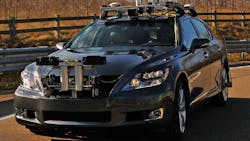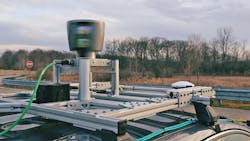Toyota exhibited a Lexus LS600 at the 2013 International CES in Las Vegas, January 8-11, along with other car vendors that were highlighting the latest electronics and automotive technology you can buy (Fig. 1). This Lexus was a different, though. The driver is optional, and it’s a little more tricked out than your local dealer’s LS600.
Toyota showed off its self-driving Lexus LS600 research vehicle (a) at the C2013 International CES in Las Vegas. It uses a 360° laser tracking system on the roof (b).
Toyota’s autonomous car looks a bit like many other driverless research vehicles, with sensors decorating its exterior. Some of them like the laser tracking system are a bit expensive but provide very precise results. The car also has forward and side radars and high-definition color cameras. On-board computing power is substantial since it handles planning as well as sensor integration.
Driverless Technology
Google’s driverless car has made it into the news quite a bit lately, though it’s been a few years since the Defense Advanced Research Projects Agency’s Grand Challenges (see “Autonomous Vehicles Tackle The Urban Jungle” at electronicdesign.com). These research vehicles now can get from one point to another without major collisions, but they aren’t ready to mix it up with their human-controlled counterparts yet.
Still, the latest driverless cars can do more than avoid buildings and other mobile vehicles. Pedestrian avoidance is good, and it’s useful even in driver-controlled cars, providing an extra set of “eyes.” But we won’t see it in the mass market unless the technology can be made reliable and inexpensive.
Google got the first license for a driverless car in Nevada for driving research vehicles on public thoroughfares. Audi, which got the second license, demonstrated its driverless car at the Mandarin Oriental hotel in Las Vegas during CES. It was essentially a robotic valet. Press the Pickup button on the Audi smart-phone app, and the car shows up at the curb.
No external sensors were instaled on the Audi itself, so it had fewer acoutrements than the Toyota research vehicle. Instead, it relied on a few blue sensors from a company called Sick in the parking lot and received information from the network. The driverless support was limited to the parking and pickup area, which was all that was necessary for the valet application, along with some intelligence.
Driverless Liability
Of course, the real barrier to driverless cars will be liability insurance. I have no doubt we’ll see driverless vehicles that meet or exceed the performance of human drivers, but insurance still is a major hurdle. Building a sufficiently safe and reliable driverless car is significantly more difficult than building a blender or medical monitor.
Everyday appliances are built with safety in mind. Of course, the standards that those devices must meet already exist. Mapping human standards for driving to a driverless car will take time. Unfortunately, it isn’t as simple as making driverless cars meet human standards because these cars can’t be held liable like people.
See what other engineers think about driverless cars on Engineering TV (see “Engineering I/O: Are You Ready For Driverless Cars On the Road?” at engineeringtv.com). Most responses are very positive. Communications Editor Lou Frenzel, though, has some doubts (see “Just Say No To The Driverless Car” at electronicdesign.com).
Driverless cars eventually will hit the streets. In the meantime, many of the technologies employed in these projects will be used in production vehicles and make driving safer.
About the Author
William G. Wong
Senior Content Director - Electronic Design and Microwaves & RF
I am Editor of Electronic Design focusing on embedded, software, and systems. As Senior Content Director, I also manage Microwaves & RF and I work with a great team of editors to provide engineers, programmers, developers and technical managers with interesting and useful articles and videos on a regular basis. Check out our free newsletters to see the latest content.
You can send press releases for new products for possible coverage on the website. I am also interested in receiving contributed articles for publishing on our website. Use our template and send to me along with a signed release form.
Check out my blog, AltEmbedded on Electronic Design, as well as his latest articles on this site that are listed below.
You can visit my social media via these links:
- AltEmbedded on Electronic Design
- Bill Wong on Facebook
- @AltEmbedded on Twitter
- Bill Wong on LinkedIn
I earned a Bachelor of Electrical Engineering at the Georgia Institute of Technology and a Masters in Computer Science from Rutgers University. I still do a bit of programming using everything from C and C++ to Rust and Ada/SPARK. I do a bit of PHP programming for Drupal websites. I have posted a few Drupal modules.
I still get a hand on software and electronic hardware. Some of this can be found on our Kit Close-Up video series. You can also see me on many of our TechXchange Talk videos. I am interested in a range of projects from robotics to artificial intelligence.



